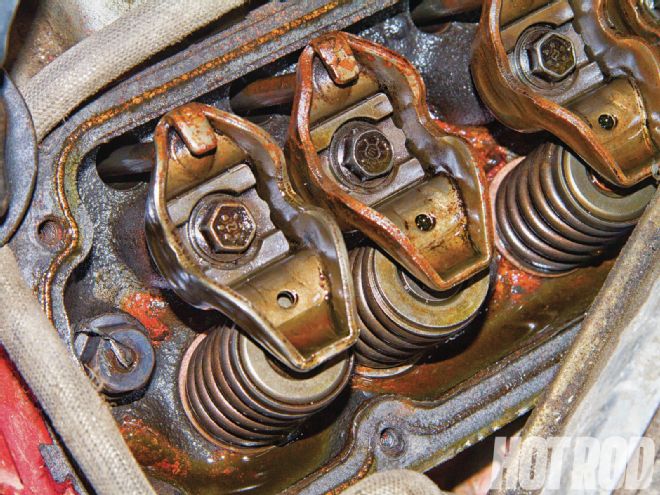
Francois Bougeant in Bloomfield, New Mexico asks:
Q: I have a '74 Ford Maverick sedan that I built a mild 306 for. It has 9.5:1 compression, ported and polished factory heads, and a cam with 276/281 degrees advertised duration and 0.471-inch valve lift. The engine is being converted to a GT-40 intake with a '93 Thunderbird 5.0L V8 ECM and wiring harness. I wanted to get a little more lift out of the rockers, but before I ordered rockers for it, I was told that using Chevy rockers would be cheaper and would produce more power. Is this true or just BS? Would the rocker geometry align correctly? Would the ECM freak out if I changed rocker ratios?
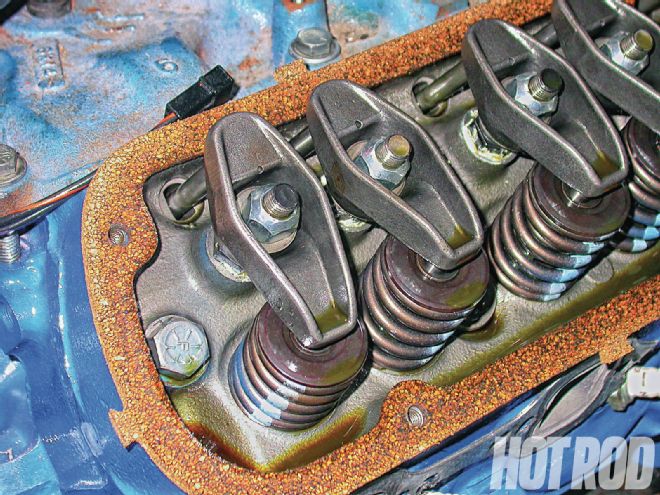 This is an old 289 high-performance, fully adjustable valvetrain for mechanical cams, circa mid-'60s. The pushrods ride on close-tolerance slots in the heads, and the rockers pivot on screw-in studs (note hex on stud where it contacts the stud boss). A small-block Chevy rocker physically fits the 3/8-inch stud, but it messes up the geometry if using standard-length Ford valves. Pic: Richard Holdener
This is an old 289 high-performance, fully adjustable valvetrain for mechanical cams, circa mid-'60s. The pushrods ride on close-tolerance slots in the heads, and the rockers pivot on screw-in studs (note hex on stud where it contacts the stud boss). A small-block Chevy rocker physically fits the 3/8-inch stud, but it messes up the geometry if using standard-length Ford valves. Pic: Richard Holdener
A: Sorry, Francois, but assuming you're using production-style Ford heads and valves, it's pretty much a big, reeking, stinking, smelly pile of BS all the way around. Let's begin with the valvetrain. Over the years, Ford has used several different production Windsor small-block V8 valvetrain configurations. Depending on the year of the engine and heads, you could have any of the following: '63–'66-1/2 standard 289/all 289 high-perf: Stud-mount rocker arms were used along with close-tolerance slots in the head to guide the pushrods and maintain rocker-arm alignment. This configuration is fully adjustable. Only the 289 high-performance engines had screw-in studs (identified by a hex midway down the stud body that bottoms against the cylinder head's stud-mounting boss). Standard-performance engines had press-in studs (no hex). Press-in studs should only be used with flat-tappet hydraulic cams.
'66-1/2–'68 standard 289/'68–'77 302 and 351W: Stud-mount, rail-type rocker arms were used along with loose-fit cylinder-head pushrod holes. The U-shaped rocker arms themselves maintain proper alignment. The standard 289 and '68-only 302 had press-in studs; the rocker-arm nut was still adjustable. The '69–'77 302/351 had a press-in, positive-stop stud; the rocker arm is not adjustable. '78-and-later 302/351W: Nonadjustable bolt-down rocker arms were used along with a stamped fulcrum guide that connects each intake/exhaust rocker-arm pair. This configuration comprises the vasty majority of used production heads you're most likely to encounter today. Dealer-installed or aftermarket valvetrain conversion: Typically, adjustable, screw-in, fully threaded studs are used with conventional (nonguided) aftermarket rocker arms, guideplates, and hardened pushrods. This configuration is recommended when moving up to a solid flat-tappet cam or any roller cam. Depending on the head, pushrod hole, pedestal boss, and/or stud boss, machining may be required.
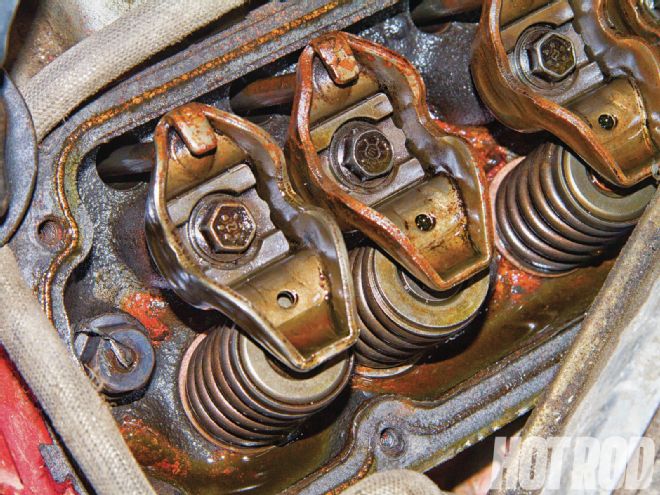 Installed by Ford on '78-and-later production engines, the pedestal-type valvetrain uses rocker arms retained by a 5/16-inch bolt. It's nonadjustable in factory-stock trim. And never mind any valvetrain geometry issues--Chevy stud-mount rockers don't even come close to fitting. Pic: Jesse Kiser
Installed by Ford on '78-and-later production engines, the pedestal-type valvetrain uses rocker arms retained by a 5/16-inch bolt. It's nonadjustable in factory-stock trim. And never mind any valvetrain geometry issues--Chevy stud-mount rockers don't even come close to fitting. Pic: Jesse Kiser
Chevy rockers don't come close to fitting pedestal-style bolt-down Ford rocker-arm valvetrains. As for the stud-mounted Ford Windsor valvetrains, small-block Chevy rocker arms--either conventional or the later, guided rail-type that match the Ford rocker style they're intended to replace--will indeed physically fit on the Ford stud, but the distance from the Chevy rocker-arm fulcrum (pivot point) to the tip is about 0.050-inch shorter compared with that on the Ford. At high lifts, the Chevy's rocker tip will roll off the end of the valve stem, the rocker body may hit the valvespring retainer, and the pushrods may bind against the slots in the heads or the guideplates. Changing pushrod length will not properly compensate for such an extreme geometry change; instead, you'll need both custom pushrods and longer valves. Often used on higher-end engines, longer valves offer more room for the stouter valvesprings typically required with huge cams, but now we're getting way beyond a budget-level approach.
Remember, too, that the stock Chevy rocker-arm ratio is 1.5:1, compared with 1.6:1 for a stock Ford. So, even discounting any loss in lift induced by improper valvetrain geometry, installing Chevy rockers on a Ford results in a decrease (not a gain) in valve lift--your present cam's 0.471-inch valve lift would drop to 0.441 inch. As for pricing, it's true that an entry-level set of 16 stamped Chevy pad-tip rockers are considerably cheaper: about $45 and $62 for the stock 1.5:1 and nonstock 1.6:1 ratios, respectively, at Summit Racing for the Chevys, versus about $110 for Summit's cheapest Ford 1.6:1 stud-mount rockers (but the aftermarket Ford rendition does have a roller tip). This changes when pricing Chevy and Ford rockers with similar nonstock characteristics (for example, with roller tips or with both a full roller trunnion and tip). As you move up the food chain, prices become roughly equivalent or even the same.
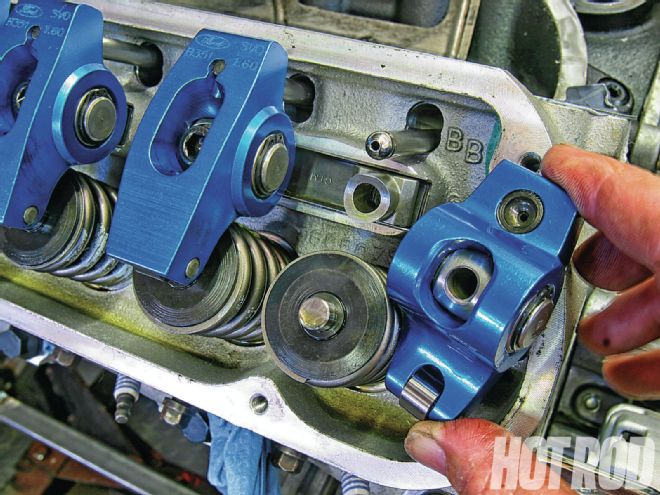 Ford Racing's M-6564-B351 1.6:1 nonadjustable pedestal roller rockers (shown) bolt directly in place of the stockers. For higher-ratio (but still nonadjustable) Cobra 1.7:1 roller rockers, order M-6564-A50 ($257.45 at Pony Parts). To achieve a modicum of adjustability with nonadjustable pedestal rockers, add a rocker-arm pedestal shim kit PN M-6529-A302 ($8.95 at Summit). Pic: Jeff Smith
Ford Racing's M-6564-B351 1.6:1 nonadjustable pedestal roller rockers (shown) bolt directly in place of the stockers. For higher-ratio (but still nonadjustable) Cobra 1.7:1 roller rockers, order M-6564-A50 ($257.45 at Pony Parts). To achieve a modicum of adjustability with nonadjustable pedestal rockers, add a rocker-arm pedestal shim kit PN M-6529-A302 ($8.95 at Summit). Pic: Jeff Smith
Actually increasing cam lift requires a higher ratio rocker. A 1.7:1 rocker develops about 0.500-inch lift with your cam. There are actually more (and cheaper) 1.7:1 rocker choices available for the Ford than there are for a Chevy small-block. For example, Summit sells a Comp Cams 3?8-inch stud, rail-style, 1.7:1 roller-tip, Ford Windsor rocker set (PN 1450-16) for $168.95, but it doesn't offer an equivalent 1.7:1, roller-tip, small-block Chevy rocker. At Summit, the cheapest 1.7:1 small-block Chevy rockers are a full-roller, Scorpion Performance set (PN SCP1025BL) that goes for $222.95. A Scorpion non-self-aligning Ford 1.72:1 full-roller, stud-mounted rocker set (PN SCP1019BL) also goes for $229.95. Don't forget that when dramatically increasing lift, you'll need to recheck the entire valvetrain, including the piston-to-valve clearance, overall rocker-arm geometry, valve-seal and valveguide clearance to the retainer, valvespring coil-bind clearance, and pushrod to head or guideplate clearance.
With or without a rocker-ratio upgrade, your existing computer calibration will have problems with the present cam profile, according to Ford engine management expert Mark Sanchez at AEW. Yes, the engine computer (aka the Electronic Control Unit or ECU) can be reprogrammed, but the going rate for that service--including a custom chip plus recalibration services--is generally around $700. Instead of recalibrating the ECU, for Ford guys like Sanchez, the more popular option is a custom-calibrated Pro-M Mass Air Flow (MAF) meter, which is about $400 to $450 out the door. Pro-M is said to be one of the only MAF outfits on the market that offer custom-calibrated MAFs. With a Pro-M–tuned MAF, the computer won't require reprogramming. Pro-M meters come custom-calibrated and pretuned for the specific combination as spec'd by the vehicle owner, so when placing the order, Pro-M needs to know the engine displacement, cylinder heads, intake manifold, cam profile, injector sizes, power-adders, and other pertinent engine mods. The stock '93 T-bird 19-lb/hr fuel injectors are marginally adequate for a street driver with your present state of modification, but for future growth consider 24-lb/hr injectors. Pro-M sells injectors, too, so it can set you up with a MAF tuned for the larger injectors at the same time.
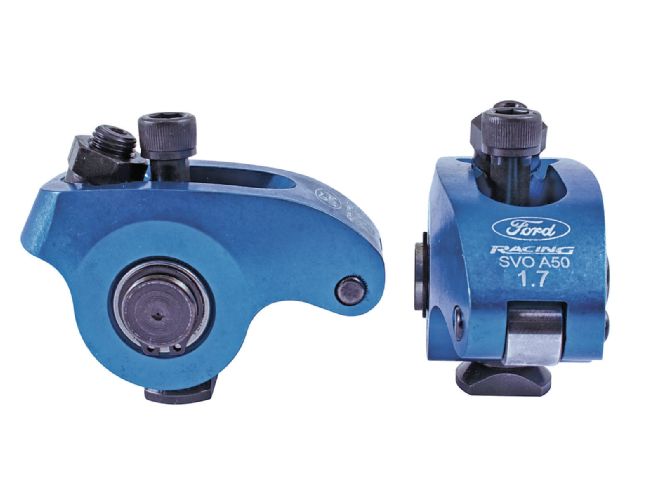 Short of head-machining for a full-bodied stud-rocker conversion (mandatory with a radical cam and stiff springs), there are several bolt-on conversion options to make a pedestal valvetrain fully adjustable, including these 1.7:1 Ford Racing rollers with an adjustable pushrod cup (PN M-6564-A50C, $368.69 at Race-Mart). Comp Cams sells a similar product (1.7:1 version, PN 1054-16). Pic: Ford Racing
Short of head-machining for a full-bodied stud-rocker conversion (mandatory with a radical cam and stiff springs), there are several bolt-on conversion options to make a pedestal valvetrain fully adjustable, including these 1.7:1 Ford Racing rollers with an adjustable pushrod cup (PN M-6564-A50C, $368.69 at Race-Mart). Comp Cams sells a similar product (1.7:1 version, PN 1054-16). Pic: Ford Racing